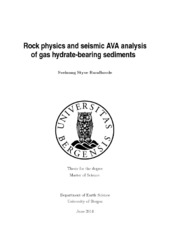Rock physics and seismic AVA analysis of gas hydrate-bearing sediments
Master thesis
Permanent lenke
https://hdl.handle.net/1956/8358Utgivelsesdato
2014-06-02Metadata
Vis full innførselSamlinger
- Department of Earth Science [1050]
Sammendrag
Large amount of natural gas are present in submarine sediments and permafrost areas in the form of gas hydrates. Gas hydrates are a large potential future energy resource, and may contribute to the methane balance in the atmosphere, causing global climate change. Dissoci- ation of gas hydrates can cause seafloor instabilities below constructions such as platforms and pipelines. It is therefore important to be able to quantify the amount of gas hydrate in the sediment. Rock physics models serve as a link between in-situ properties in the rock and observable prop- erties at the surface. Information regarding seismic properties can be extracted from AVA data via a reflectivity model, and related to hydrate saturation using a rock physics model. Three phase effective medium theory, and a combination of the self consistent approximation and dif- ferential effective medium theory are implicated and compared. Large differences in estimated properties were observed for the different models. When a forward model has been applied, that relates reservoir parameters to AVA data, esti- mates on these parameters on the basis of data can be made. When the data contain noise, errors in the data are mapped to the estimates on model parameters. Uncertainty analysis was performed in order to investigate the effects of errors in the data. It was seen that when the "true" model is used for inversion, it is possible to make good estimates on the model parameters. When a different model was used for inversion than for the forward modeling, the estimates where good in some cases, and very poor in other.
